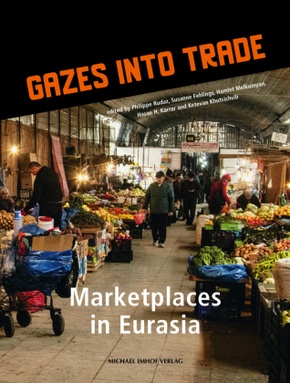| Verlag | Imhof |
| Auflage | 2024 |
| Seiten | 192 |
| Format | 24,5 x 2,0 x 31,8 cm |
| Gewicht | 1400 g |
| ISBN-10 | 3731914174 |
| ISBN-13 | 9783731914174 |
| Bestell-Nr | 73191417A |
Basare sowie informelle und halbformale Marktplätze dienen nicht nur als wirtschaftliche Zentren, sondern auch als wichtige soziale Räume, die verschiedene Ebenen des Gemeinschaftslebens und der Interaktion umfassen. Im Rahmen eines sechsjährigen interdisziplinären Forschungsprojektes zu informellen Märkten und Handelspraktiken im Kaukasus und in Zentralasien sammelten zwischen 2016 und 2022 engagierte Forscherinnen und Forscher eine Vielzahl von ethnografischen Daten in Georgien, Armenien, Kasachstan, Kirgisistan und China. Die Fotografien in diesem Buch repräsentieren einen Teil dieser Daten. Sie stammen zwar nicht von professionellen Fotografen, bestechen aber durch die authentische Darstellung verschiedener Aspekte des Alltagslebens. Diese Aspekte werden in getrennten Kapiteln (z.B. zu Infrastruktur, Prekarität und Geschlecht etc.) dargestellt und erläutert. Wir laden die Leser ein, sich beim Umblättern der Seiten in die visuelle Soziologie der eurasischen Marktplätze zu verti efen und dabei der Komplexität informeller Wirtschaftspraktiken nachzugehen und die tiefgreifenden Auswirkungen von Marktplätzen auf die lokalen kulturellen und wirtschaftlichen Landschaften zu entdecken.This book represents the culmination of a six-year interdisciplinary research project on informal trade and marketplaces in the Caucasus and Central Asia. Spanning from 2016 to 2022, the project involved a dedicated team of researchers gathering an array of data, ethnographic material, and personal interviews across Georgia, Armenia, Kazakhstan, Kyrgyzstan, and China. Bazaars and informal and semiformal marketplaces serve not just as economic hubs but as vital social spaces that encapsulate various layers of community life and interaction. The photographs in this book, while not the work of professional photographers, are presented with a commitment to authenticity and a focus on the realities of daily life in these markets. Aesthetics, though considered, are secondary to the hone st depiction of the diverse aspects of informal trade explored in the different chapters (infrastructure, precarity, gender, to cite a few). As you turn the pages, you are invited to delve into the visual sociology of marketplaces, to appreciate the complexities of informal economies, and to recognize the profound impact of these spaces on the cultural and economic landscapes of the regions they serve.
This book represents the culmination of a six-year interdisciplinary research project on informal trade and marketplaces in the Caucasus and Central Asia. Spanning from 2016 to 2022, the project involved a dedicated team of researchers gathering an array of data, ethnographic material, and personal interviews across Georgia, Armenia, Kazakhstan, Kyrgyzstan, and China. Bazaars and informal and semiformal marketplaces serve not just as economic hubs but as vital social spaces that encapsulate various layers of community life and interaction. The photographs in this book, while not the work of professional photographers, are presented with a commitment to authenticity and a focus on the realities of daily life in these markets. Aesthetics, though considered, are secondary to the honest depiction of the diverse aspects of informal trade explored in the different chapters (infrastructure, precarity, gender, to cite a few). As you turn the pages, you are invited to delve into the visual sociology of marketplaces, to appreciate the complexities of informal economies, and to recognize the profound impact of these spaces on the cultural and economic landscapes of the regions they serve.

